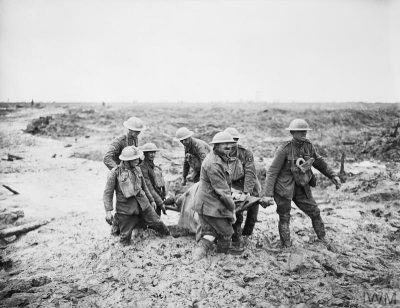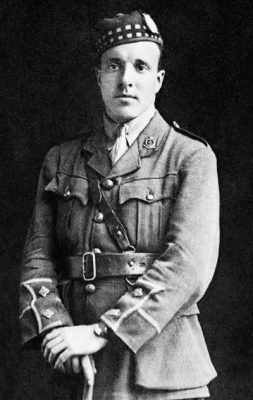A few years back, we celebrated the centenary of the Third Battle of Ypres (31 July – 10 November 1917). The battle was an attempt by Allied forces to break through German lines and cut access to North Sea U-boat bases, which were proving a threat to Atlantic shipping. The battle resulted in marginal territorial gain, and cost half a million casualties. It is remembered for the heavy rains which, following artillery bombardments that had destroyed the drainage ditches, turned the agricultural land into deep mud: “I died in hell – (They called it Passchendaele)” (Siegfried Sassoon, 1918).
In such conditions the stretcher bearers had a dreadful job. Quick to follow soldiers out of the trenches, carrying heavy wooden stretches, blankets and medical panniers, they were intended to operate as a team of six, but often only two or three was typical. They would continue back and forth across the battlefield under fire, applying first aid, making decisions on who to tend first, who to leave and who to carry back to the lines.

The conditions at Ypres made the job of the bearer teams that much worse – deep fetid mud, sometimes so bad that it drowned men, often littered with dead horses and body parts, and hiding discarded ordnance. It was here that the only double recipient of the Victoria Cross (VC), the highest military award for gallantry, in the Great War, Captain Noel Chavasse of the Royal Army Medical Corp, attached to the 10th Battalion King’s (Liverpool) Regiment, set up an advanced first-aid post in a captured German dugout.

Chavasse was awarded a Military Cross (MC) at the Second Battle of Ypres (1915) and a VC at the Battle of the Somme (1916). At Passchendaele he suffered a fractured skull, was treated for this injury and returned to his post; he suffered two further head injuries, instructed stretcher bearers to take other wounded to safety whilst he remained with men who could not be moved. On 2 August he received a stomach wound requiring treatment at a casualty clearing station. He died of his injuries on 4 August 1917, aged 32.
His VC citation reads: “Though severely wounded early in the action whilst carrying a wounded soldier to the dressing station, he refused to leave his post, and for two days not only continued to perform his duties but went repeatedly under enemy fire to search for and attend to wounded who were lying out. During these searches, although practically without food, he assisted to carry a number of badly wounded men over difficult ground. By his extraordinary energy and inspiring example he was instrumental in rescuing many who would have otherwise undoubtedly succumbed under the bad weather conditions.”
The Wounded gallery, which closed in 2018, is a quiet area, away from the main museum, fitting for the reflective nature of the exhibition. Visitors may have a connection to the Great War, a professional or educational interest in medical developments, or are simply curious. Most leave humbled by a glimpse into the impact of the conflict on our armed forces and of the corresponding challenges faced by the medical establishment.
This post was written by Nigel Rothwell, who was one of our Wounded volunteers. If you’re interested in volunteering at the Museum you can find out about current opportunities on our volunteering page.